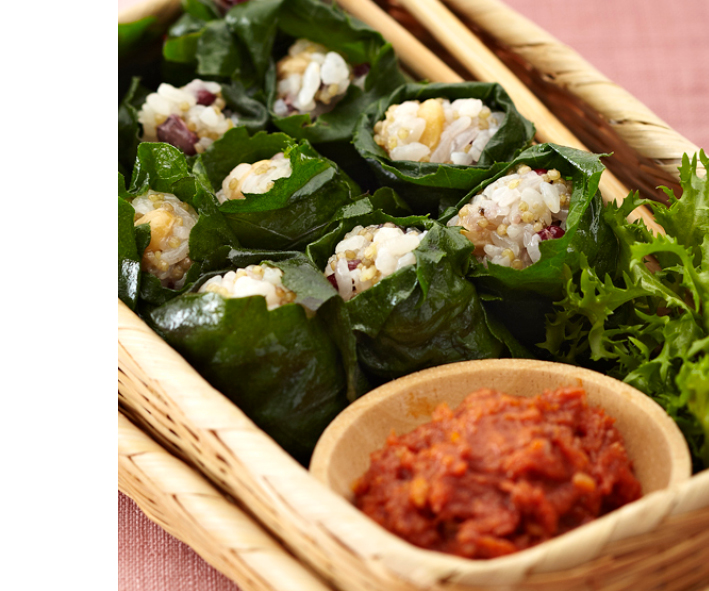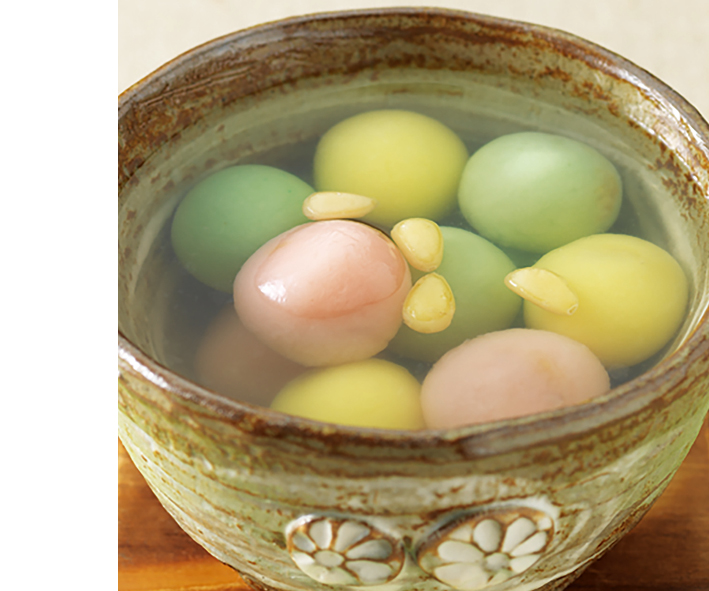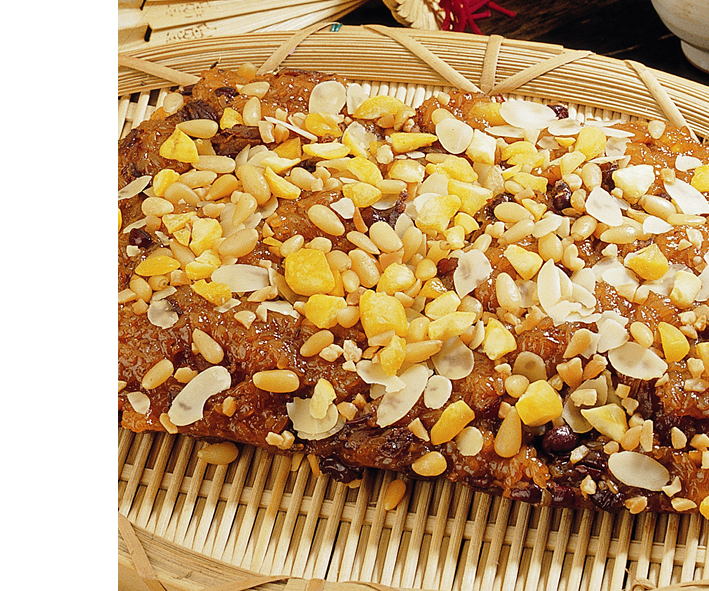한식 읽기 좋은 날
Vol 48. Food for Good Health
Unique Seasonal Dish Recipes for Jeongwol Daeboreum ─ That We Did Not Know
Discovery of Korean Food
When it comes to food eaten on Jeongwol Daeboreum(the first full moon day of the new year), it is easy to think of only ogokbap, mugeunnamul, and bureom. In the past, however, our people prepared and ate colorful food with devotion and skill wishing for health and happiness. The old Korean saying, “Good-looking rice cakes are better to eat,” is contained in the holiday table setting, boasting of a beautiful shape and color.
Reference. Rural Development Administration Agri-Food Olbaro
Bokssam • Wrapping and Eating Fortune to Wish for Health and Peace
There are very few people who like ssam like us. Our people, who used to eat rice wrapped in leafy vegetables that are harvested from the mountains or fields every season, also served ssambap(leaf wraps and rice) on the table during the first full moon day of the year. This goes one step further from our food culture, in which we simply enjoyed ssambap, and adds the meaning of “wrap and eat fortune.” On this day, rice is wrapped in leafy greens or gim(dried laver), such as edible aster leaves, cabbage leaves, groundsel leaves, and castor leaves, and is called “bokssam.” It was believed that fortune and a good year would come if you piled up bokssam in a bowl like a sheaf of rice, and ate it.
 Ingredients
Ingredients
180 g non-glutinous rice, 80 g soybean, 20 leaves edible aster leaves, 340 g sticky rice, 110 g red beans, 70 g millet, and a little bit of sesame oil and salt
How to make it
① Wash non-glutinous rice, sticky rice, red beans, soybeans, and millet thoroughly, soak in water, and add salt to cook ogokbap.
② Add sesame oil to the de-steamed rice, and mix well to make an oval-shaped rice ball by holding it tightly with your hands.
③ Blanch the groundsel leaves with the stems removed in boiling water with a little salt, and rinse in cold water. Dry with a dry cotton cloth, and season with sesame oil. At this time, if you squeeze it too tightly with your hands, it will become soft.
④ Put the rice balls in the groundsel leaves, make ssams, and serve with ssamjang(red chili and soybean paste).
Hodugotgamssam • Enjoying Sweetness on the New Year
Hodugotgamssam(walnut and dried persimmon wraps), which offers a great harmony of nutty walnut and sweet and chewy gotgam, is a snack that was often present on the refreshment table on the first full moon day because of its taste and fancy appearance. Nowadays, it is rarely eaten in daily life as it is being used only for pyebaek(formal greetings from the newlyweds after the wedding ceremony) food or ibaji(wedding) food. But it is simple to make, so you can decorate it in sujeonggwa(cinnamon punch), or serve it as a side dish for the liquor table to create a more splendid table setting.
 Ingredients
Ingredients
5 gotgam, 100 g(10) walnuts, honey(or corn syrup)
How to make it
① Select gotgams that are soft and not too large, remove the stem, cut in half, and remove the seeds.
② Prepare walnuts by cutting the inside in half and peeling the inner skin cleanly.
③ Put the prepared walnuts in gotgam, wrap it tightly, and apply honey to the edge so that it does not loosen. Then, trim the upper and lower parts to make them look good, and cut them into 2 to 3 equal parts before serving them.
Wonsobyeong • Bright Moon in a Bowl
The origin of “wonsobyeong” came from the name of a rice cake eaten while looking at the moon on the first full moon day of the year in China. However, our people enjoyed it differently in the form of hwachae(punch) by putting stuffing in colorful sticky rice dough, making them into small balls, cooking them in water, and putting them in cold honey water. The doughs are made by putting the juice of gardenia, schizandra, mugwort, etc., into the sticky rice powder so the rice balls in a bowl itself is wonderful to look at. Wonsobyeong is a dish made and eaten on the evening of the full moon day of the new year with the whole family sitting around and praying for peace in the family.
 Ingredients
Ingredients
200 g sticky rice powder, the juice of gardenia, schizandra, mugwort, 2 tbsp starch, 50 ml water, 1 tbsp pine nuts, 10 jujubes, 1/4 citron peel, 2 tbsp honey, 200 ml sugar, 1 L water
How to make it
① Sift the sticky rice powder through a sieve, divide it into 3 bowls, and pour the juice from each gardenia, schizandra, and mugwort, and knead with hot water.
② Pour water into a pot, add sugar, bring to a boil, and cool.
③ Remove the seeds of jujubes, chop finely along with the citron peel, mix with honey, and cut open about 0.8 cm each to make stuffing.
④ Take the sticky rice dough in the size of a jujube, put the stuffing in, and make a 1.5 cm-diameter round shape.
⑤ Dip ④ in the starch evenly, blanch in boiling water, put it in cold water to cool, and then drain.
⑥ Put wonsobyeong in a bowl, pour ②, and add pine nuts.
Sangwon Yakban • Sweet and Savory Rice Becomes Medicine
If ogokbap is the seasonal dish of the common people, the upper classes made and ate yakbap. It was called Sangwon Yakban because it is said that they eat yakban, a sticky rice that is steamed with jujubes, chestnuts, pine nuts, sesame oil, honey, and soy sauce on the first full moon day of the new year, which is called sangwon in Chinese. In the past, honey was regarded as medicine(yak), so the cookies coated with honey were called yakgwa, and the rice added with honey was called yakbap. However, strictly speaking, yakbap belongs to rice cake. When honey was scarce, gotgam was an essential sweetening ingredient instead of honey. The seeds of gotgam are removed, the gotgam is soaked, mixed in with other ingredients and cooked on a subtle heat, and then the sweet scent and pretty color of gotgam is seeped into yakbap, making beautiful sangwon “gotgam” yakban.
 Ingredients
Ingredients
800 g sticky rice, 1/2 tbsp salt, 1 cup water, 3 gotgams, 10 chestnuts, 20 jujubes, 2 tbsp pine nuts
Sauce: 3 tbsp soy sauce, 1/2 cup brown sugar, 4 tbsp sesame oil, 1 tsp cinnamon powder, 1/3 cup honey, caramel sauce(6 tbsp sugar, 3 tbsp water, 3 tbsp boiling water, 1 tbsp corn syrup)
How to make it
① Wash the sticky rice thoroughly, and soak in water for at least 3 hours. Lay a cotton cloth on the hot steamer, and place the sticky rice in it. When the steam rises, pour salted water over it repeatedly at interval, mix thoroughly with a spatula, and cook for about an hour.
② Trim the gotgam stems, peel all the inner skins of chestnuts, and cut them into 5-6 pieces.
③ Remove the jujube stems, clean jujubes, and then cut them into 5 to 6 equal parts. Remove the cap from pine nuts.
④ When ① is hot, put it in a large bowl, and spread it out. Add sugar, cinnamon powder, soy sauce, caramel sauce, and sesame oil, and mix well.
⑤ Add sesame oil, chestnuts, jujubes, and pine nuts, and mix again. Steam over high heat over water first, then over medium heat over water for 2 hours.










